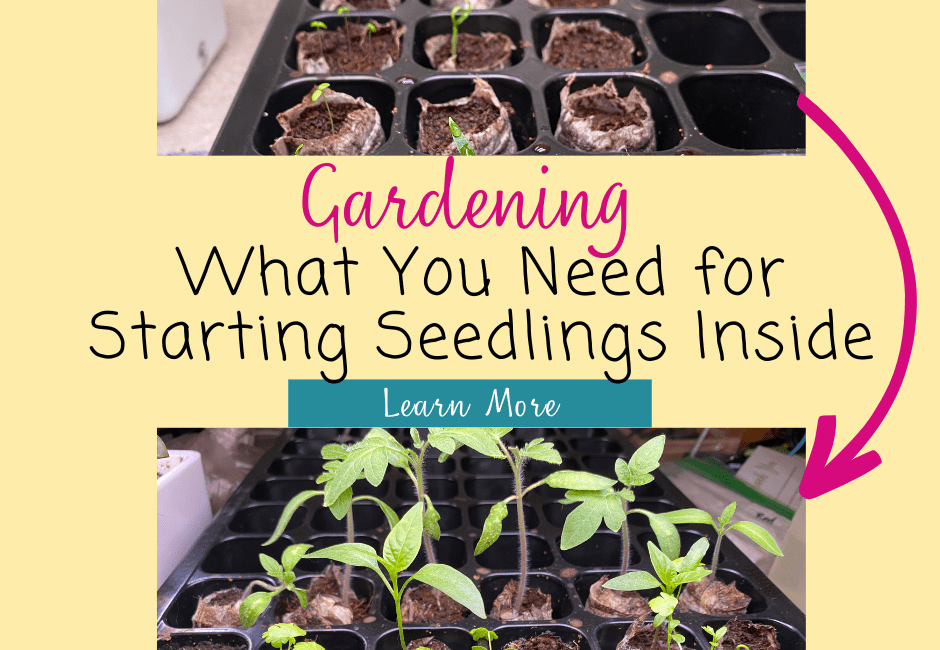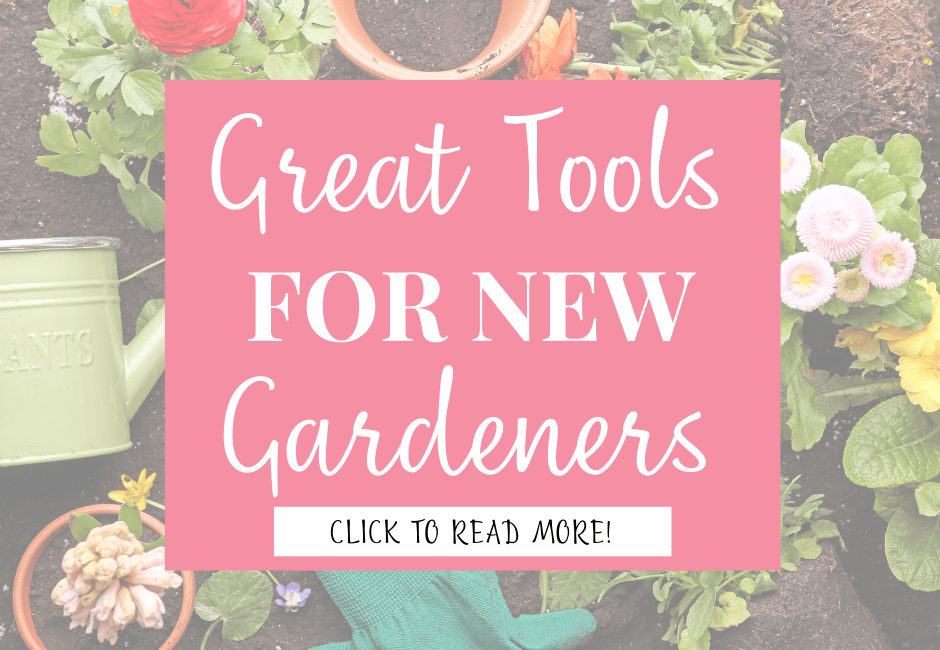Are you starting a garden and wondering what you need for starting seedlings inside before it’s warm enough to plant them outside? Here is what I’ve found to work the best!
Note: As an Amazon Affiliate I earn from qualifying purchases made through affiliate links, at no extra cost to you. Read my full disclosure for more information.
Starting Seedlings Inside
I started my seeds inside using some of the products I’ll link below. This year I planted or am planting the following seeds: cherry tomatoes, regular tomatoes, celery, carrots, broccoli, parsley, oregano, cilantro, basil, zucchini, onions, peas, lettuce, cucumber, bell peppers, and kale.
I used peat pellets for my seedlings and put them into a starter tray with a humidity dome. I kept the dome on until they started to sprout and then removed it.
I’ve had lights on them for 12 hours a day and have made sure they are watered but not drowning.
I transferred them into 1 gallon pots when they outgrew the starter tray, especially the tomatoes and peppers as I know I’ll be having them in 5 gallon pots later when I have them outside. I’m sure I’ll write more blog posts when that time comes!
Do you want to start some seedlings? Here’s what you need to get started.
Below is an image of my first little seeds sprouting!! As you can see, within four days they went from barely sprouting to full sprouts!

Seeds
There are different types of seeds such as organic, non-GMO, and heirloom. I tend to go with organic but it’s up to you. I’ve found that organic seeds tend to be easier to find in garden centers or hardware stores with a garden center. Below are some options for shopping online. There are also a lot of seed catalogs gardeners love. You can view them online or have them sent to your home.
Basic Veggies 10 pack of organic seeds: Cilantro, Basil, Onion, Tomato, Spinach, Arugula, Lettuce, Carrot, Bean & Radish Seeds.
Organic 20 Pack Veggie & Herb Seeds
20 Pack of organic vegetable seeds AND herbs!!
Burpee Non-GMO Heirloom Vegetable Seeds
Burpee is a trusted brand when it comes to gardening! There are many varieties of seeds online, in stores, and garden centers!
Soil for Starting Seedlings
From what I’ve learned, you don’t have to use seed starter soil for seedlings. You surely can but it’s likely that you’ll end up with some at the end of your seedling phase and it’s really not that much more beneficial for them than regular soil. Do be sure that you get a soil that is for indoor and outdoor use since you’ll be starting the seeds indoors. If you want an organic garden, be sure to get organic soil.
Like many beginners, I started with Peat Pellets that expand when you soak them in water and then you take the top part of the casing off so you can insert the seed.
Make sure you read your seed packet to see how deep the seed should be under the soil.
Starter Tray
You’ll need somewhere to put the peat pellets or soil and seeds which can be as simple as solo cups, small pots, toilet paper rolls, or egg cartons. Be sure that whatever you use is clean. Remember, you’ll be eating what grows here!
This Burpee Self-Watering seed starting system not only has a place for the soil and seeds but also includes peat pods so you don’t have to buy them separately. As I stated above, the Burpee brand is a trusted one among gardeners.
There are many other variations as well including silicone ones that look promising as well.
Lights!
Grow lights are essential when starting seeds inside as even a South facing window won’t provide enough light for your seedlings, especially in the winter.
Seedlings need between 12-16 hours of light a day. You don’t have to get super fancy expensive lights for them to grow.
The first set of LED lights are easy to move the arms around where you need them and adjust from being just right above the seedlings before they get big to higher as they grow and need more light. They also have a built in timer so they’ll turn on automatically every day and turn off after the time you’ve set. I have mine turn on at 7:30am and turn off at 7:30pm.
The lights that are on the left with three arms have gotten my plants going but through further research I have found that it’s best to have more robust grow lights, with 3200-5000 lumens per light being ideal, depending on who you talk to. Hence why I’m showing this 6-oack of grow lights that are 2 feet each and are brighter than the cheaper lights.
These lights are the perfect size for hanging in the mini greenhouse below.
Pots for Transplanting
Once your seedlings are outgrowing their starter pods, you’ll want to transplant them into larger pots if it’s not warm enough for them to be outside yet. Here are my not so little guys, most of whom are ready to be transplanted!
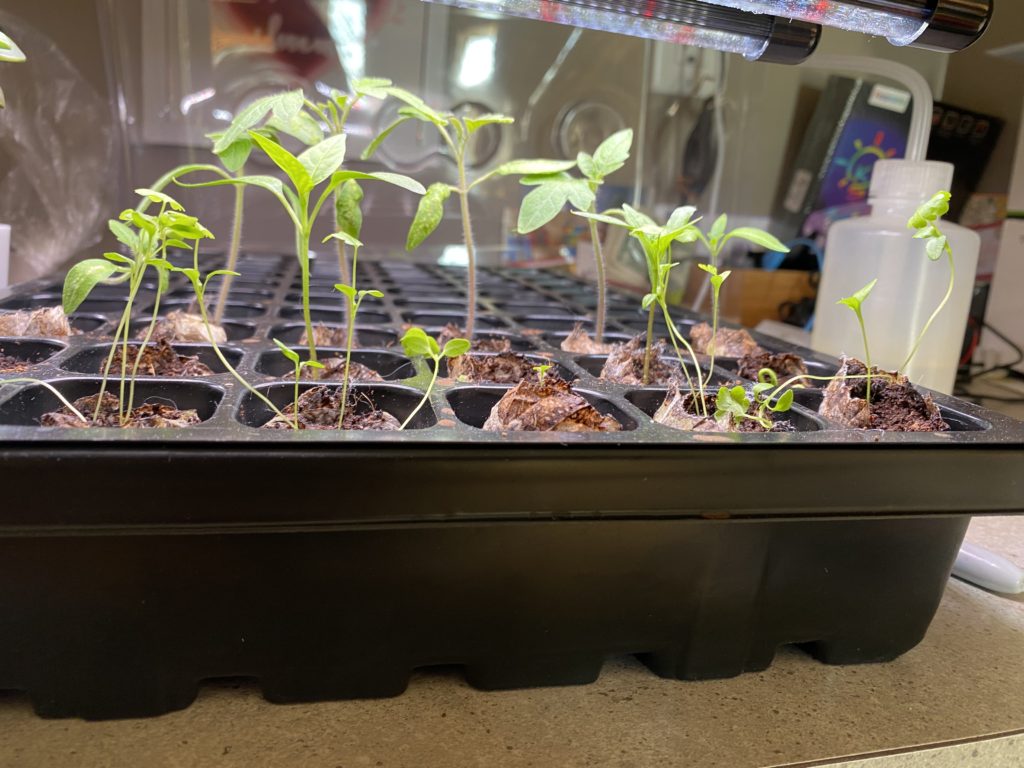
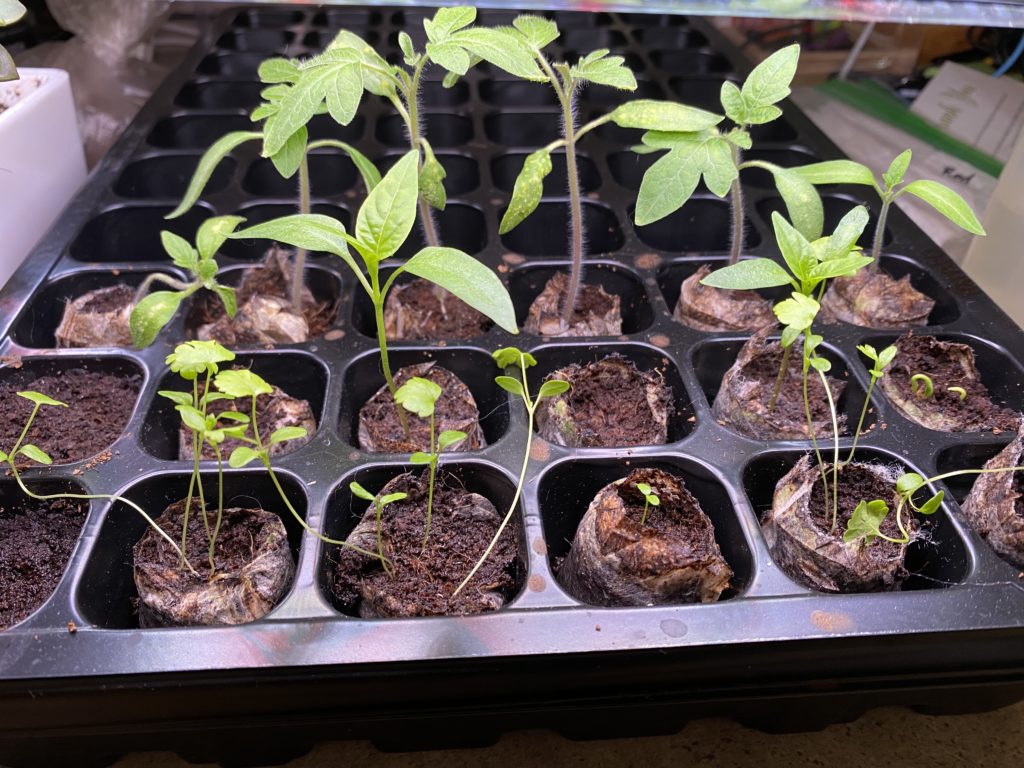
If you’re transplanting tomatoes and peppers, among other things, getting 1 gallon pots are ideal for this in-between phase before they graduate to outside in the ground or 5 gallon or bigger pots.
This is a 12 pack, so keep that in mind…Don’t think you need 12 of them? That’s what I thought too but once I started tallying up how many seedlings are doing amazing and outgrowing their pots, plus the herbs I want to grow inside, I’m left wondering if I’ll have enough! Haha!
Note: I did wash these before I used them since I figure I’ll be eating out of them in a sense, since I’m eating what they grow. Probably not necessary but makes me feel a bit safer.
Soil for Transplanting and Outside
I chose organic soil and seeds though of course what you choose is up to you. I realize the peat pellets probably aren’t organic but I didn’t know better when I started. At least I can try to make the rest organic as possible!
The Espoma Organic Potting Soil mix is what I got for my transplants into pots. I have another type of soil that is similar but comes in bigger bags and a bit less expensive for when I fill my raised garden bed as I’ll need a lot of soil for that!
This is a great brand with great reviews on Amazon and from other gardeners in Facebook gardening groups I’m in and other blogs.
Gardening Tools
From when you start transplanting to larger pots or straight to the garden, you’re going to need some gardening tools. Below is a blog post I wrote about my favorite gardening tools.
Make sure that you wash your tools at the beginning of each season (I honestly just found out this was a thing, I had never thought about it before!)
Click below to see my blog post about great tools for gardening!
Need More Space?
If you need more space or need to keep pets or kids out of your seedlings, this is a great solution!
There are many different sizes, this is one of the smaller ones.
You can also attach the strips of LED lights I mentioned above to the underside of the shelves so your seedlings get light.
At first I did without one of these but once I transplanted my tomatoes and peppers into larger pots, then needed to start transplanting others, I bought one of these and the LED strip lights which are great! Below you can see my current set up with the LED lights attached to the shelves and my seedlings on top. There is a lot of room on this, more than I had expected, which is great because I just had to buy more of the 1 gallon pots to transplant more seedlings! So exciting!!
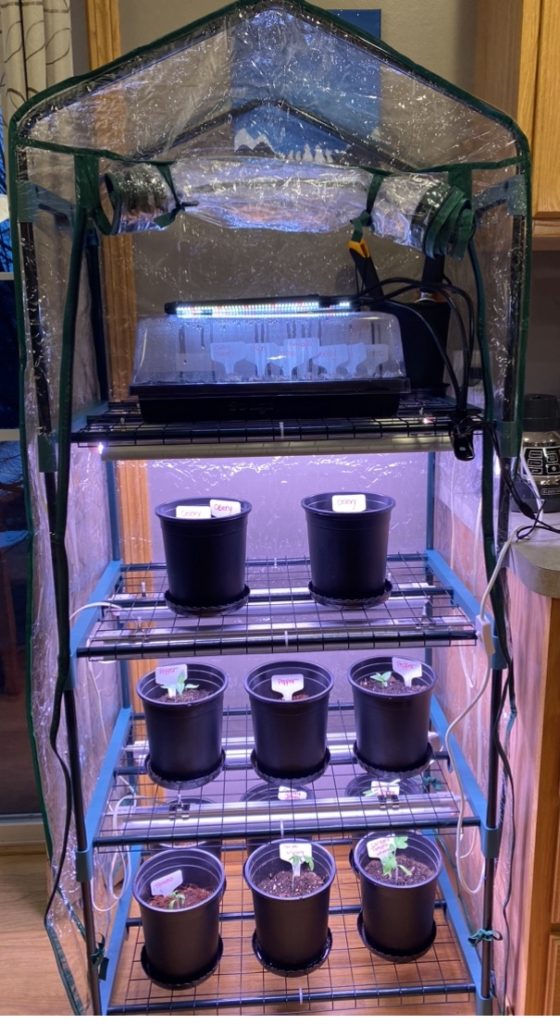
Books
If you know me, you know I am huge into researching anything and everything before jumping in. Here are a couple of books I’ve found to be helpful.
Planter App
I came across an awesome app that has helped so much in terms of planning out my garden, keeping track of everything, and learning more about what to do.
The best thing? This app is FREE!!! With the free version you can design 1 garden, see which plants are companion plants and which ones shouldn’t be planted near each other. You can also learn more about the plants/veggies, different varieties, when to plant and where (inside/outside/how much sun, etc.). It really is a wealth of knowledge.
After using it for a couple of weeks I decided to buy the premium version which is currently only $11.99 for a year! That’s about $1/month. With the premium version you can add additional gardens, take notes about your plants such as when you started them as a seed, when you transplanted them, etc. get access to the app on your computer as well as your phone or tablet, and more! I also wanted to support the developer since they created an amazing app!
Below are some screenshots of my garden. As you can see, I have a main garden planned, as well as some tomato pots, an herb garden and possibly more. The second photo shows my main garden and the green half circles indicate when two plants will help each other out. If they are harmful to each other there would be a red half circle. The third photo is what I see once I click through on “Bell Peppers” on my app. I’m able to see pictures of peppers, different types, the variety I selected that I’m planting, the notes I added including when I transplanted them, and below that is even more information. Seriously, this app is packed with SO much!!
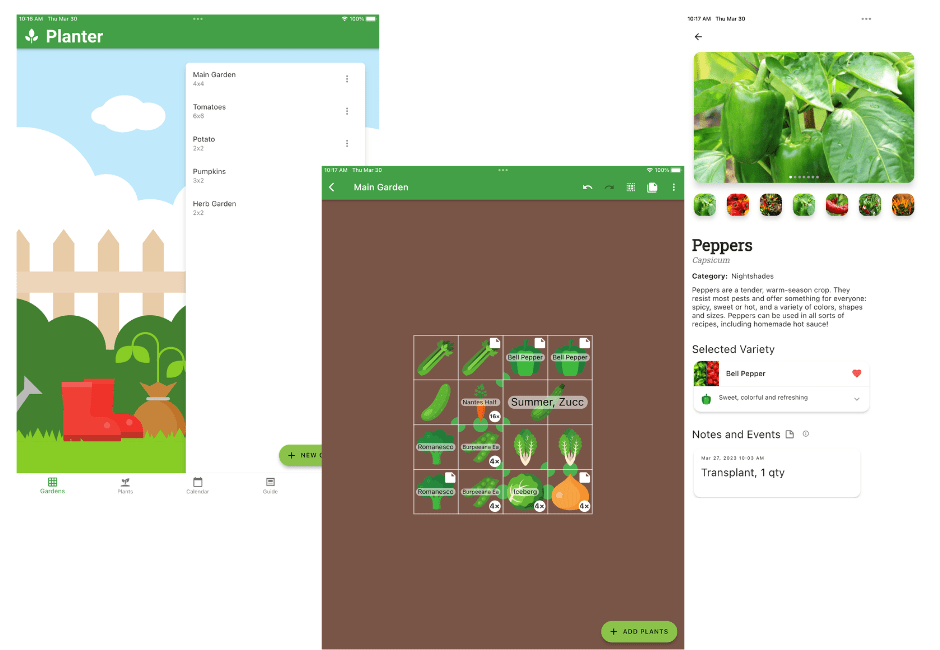
This is Only the Beginning…
I will write other gardening posts as I continue my gardening journey! Sign up to receive my monthly newsletter with a recap of new posts if you want to know when the new gardening posts are published.
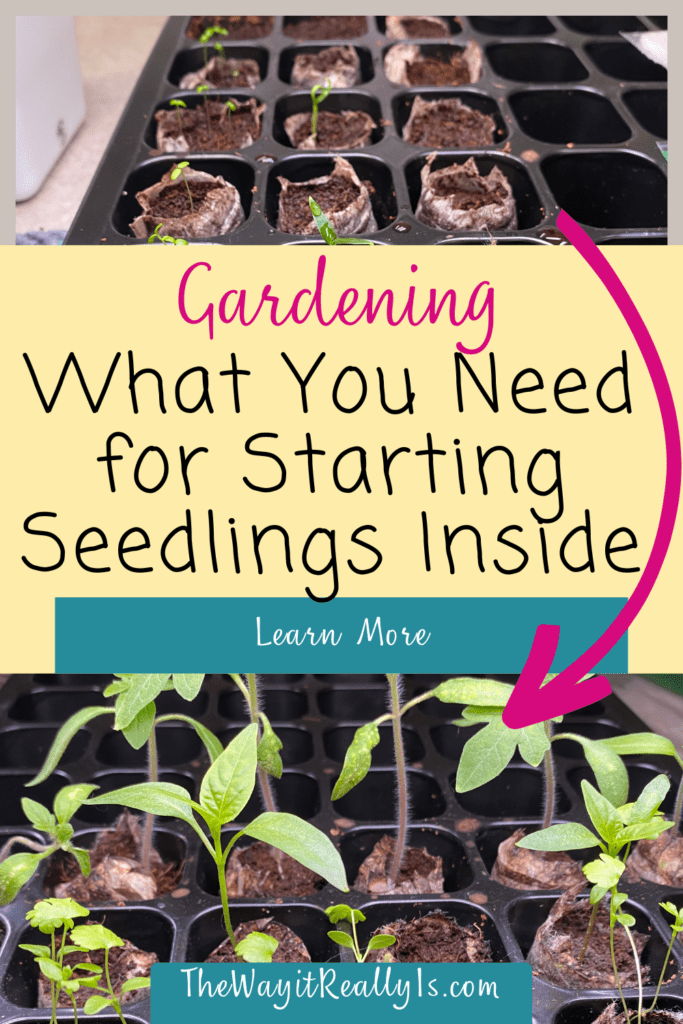
As a mom of identical twins and a son two years older, I have gained invaluable experience in the realm, and chaos, of parenting. With a Master's Degree and Education Specialist Degree in School Psychology, I spent years as a school psychologist, helping children navigate through their educational and emotional challenges. Now as a stay at home mom and professional blogger, I combine my areas of expertise to help you in your parenting journey.

